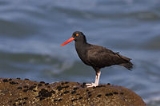
Oystercatcher
Encyclopedia
The oystercatchers are a group of wader
s; they form the family
Haematopodidae, which has a single genus
, Haematopus. They are found on coasts worldwide apart from the polar regions and some tropical regions of Africa and South East Asia. The exception to this is the Eurasian Oystercatcher
and the South Island Oystercatcher, both of which breed inland, far inland in some cases. In the past there has been a great deal of confusion as to the species limits, with discrete populations of all black oystercatchers being afforded specific status but pied oystercatchers being considered one single species.
The name oystercatcher was coined by Mark Catesby
in 1731 as a common name
for the North America
n species H. palliatus, described as eating oyster
s. Yarrell
in 1843 established this as the preferred term, replacing the older name Sea Pie.
is the lightest on average, at 526 g (1.2 lb), while the Sooty Oystercatcher
is the heaviest, at 833 g (1.8 lb). The plumage
of all species is either all-black, or black (or dark brown) on top and white underneath. The Variable Oystercatcher
is slightly exceptional in being either all-black or pied. They are large, obvious, and noisy plover
-like bird
s, with massive long orange or red bills used for smashing or prying open molluscs. The bill shape varies between species, according to the diet. Those birds with blade-like bill tips pry open or smash mollusc shells, and those with pointed bill tips tend to probe for annelid
worms. They show sexual dimorphism
, with females being longer-billed and heavier than males.
The diet of oystercatchers varies with location. Species occurring inland feed upon earthworm
s and insect larvae. The diet of coastal oystercatchers is more varied, although dependent upon coast type; on estuaries bivalves, gastropods and polychaet worms are the most important part of the diet, where rocky shore oystercatchers prey upon limpets, mussels, gastropos and chiton
s. Other prey items include echinoderm
s, fish, and crabs.
All species of oystercatcher are generally monogamous
, although there are reports of polygamy in the Eurasian Oystercatcher. They are territorial
during the breeding season (with a few species defending territories year round). There is strong mate and site fidelity in the species that have been studied, with one record of a pair defending the same site for 20 years. A single nesting attempt is made per breeding season, which is timed over the summer months. The nests
of oystercatchers are simple affairs, scrapes in the ground which may be lined, and placed in a spot with good visibility. The eggs of oystercatchers are spotted and cryptic. Between one and four eggs are laid, with three being typical in the Northern Hemisphere and two in the south. Incubation
is shared but not proportionally, females tend to take more incubation and males engage in more territory defence. Incubation varies by species, lasting between 24–39 days. Oystercatchers are also known to practice "egg dumping." Like the cuckoo, they sometimes lay their eggs in the nests of other species such as seagulls, abandoning them to be raised by those birds.
One species of oystercatcher became extinct during the 20th century, the Canarian Oystercatcher. Another species, the Chatham Oystercatcher, which is endemic to the Chatham Islands
of New Zealand, is listed as endangered by the IUCN, and the African Oystercatcher is considered near threatened. In the past there has been conflict with commercial shellfish farmers, but studies have found that the impact of oystercatchers is much smaller than that of shore crabs.
Wader
Waders, called shorebirds in North America , are members of the order Charadriiformes, excluding the more marine web-footed seabird groups. The latter are the skuas , gulls , terns , skimmers , and auks...
s; they form the family
Family (biology)
In biological classification, family is* a taxonomic rank. Other well-known ranks are life, domain, kingdom, phylum, class, order, genus, and species, with family fitting between order and genus. As for the other well-known ranks, there is the option of an immediately lower rank, indicated by the...
Haematopodidae, which has a single genus
Genus
In biology, a genus is a low-level taxonomic rank used in the biological classification of living and fossil organisms, which is an example of definition by genus and differentia...
, Haematopus. They are found on coasts worldwide apart from the polar regions and some tropical regions of Africa and South East Asia. The exception to this is the Eurasian Oystercatcher
Eurasian Oystercatcher
The Eurasian Oystercatcher Haematopus ostralegus, also known as the Common Pied Oystercatcher, or just Oystercatcher, is a wader in the oystercatcher bird family Haematopodidae. It is the most widespread of the oystercatchers, with three races breeding in western Europe, central Eurasia,...
and the South Island Oystercatcher, both of which breed inland, far inland in some cases. In the past there has been a great deal of confusion as to the species limits, with discrete populations of all black oystercatchers being afforded specific status but pied oystercatchers being considered one single species.
The name oystercatcher was coined by Mark Catesby
Mark Catesby
Mark Catesby was an English naturalist. Between 1731 and 1743 Catesby published his Natural History of Carolina, Florida and the Bahama Islands, the first published account of the flora and fauna of North America...
in 1731 as a common name
Common name
A common name of a taxon or organism is a name in general use within a community; it is often contrasted with the scientific name for the same organism...
for the North America
North America
North America is a continent wholly within the Northern Hemisphere and almost wholly within the Western Hemisphere. It is also considered a northern subcontinent of the Americas...
n species H. palliatus, described as eating oyster
Oyster
The word oyster is used as a common name for a number of distinct groups of bivalve molluscs which live in marine or brackish habitats. The valves are highly calcified....
s. Yarrell
William Yarrell
William Yarrell was an English bookseller and naturalist.Yarrell is best known as the author of The History of British Fishes and The History of British Birds . The latter went into several editions and was the standard reference work for a generation of British ornithologists...
in 1843 established this as the preferred term, replacing the older name Sea Pie.
Appearance and habits
The different species of oystercatcher show little variation in shape or appearance. They range from 39–50 cm (15.4–19.7 in) in length and 72–91 cm (28.3–35.8 in) in wingspan. The Eurasian OystercatcherEurasian Oystercatcher
The Eurasian Oystercatcher Haematopus ostralegus, also known as the Common Pied Oystercatcher, or just Oystercatcher, is a wader in the oystercatcher bird family Haematopodidae. It is the most widespread of the oystercatchers, with three races breeding in western Europe, central Eurasia,...
is the lightest on average, at 526 g (1.2 lb), while the Sooty Oystercatcher
Sooty Oystercatcher
The Sooty Oystercatcher, Haematopus fuliginosus, is a species of oystercatcher. It is a wading bird native to Australia and commonly found on its coastline. It prefers rocky coastlines, but will occasionally live in estuaries....
is the heaviest, at 833 g (1.8 lb). The plumage
Plumage
Plumage refers both to the layer of feathers that cover a bird and the pattern, colour, and arrangement of those feathers. The pattern and colours of plumage vary between species and subspecies and can also vary between different age classes, sexes, and season. Within species there can also be a...
of all species is either all-black, or black (or dark brown) on top and white underneath. The Variable Oystercatcher
Variable Oystercatcher
The Variable Oystercatcher is a species of wader in the Haematopodidae family.It is endemic to New Zealand. The Maori name is torea-pango. They are also known as 'red bills'....
is slightly exceptional in being either all-black or pied. They are large, obvious, and noisy plover
Plover
Plovers are a widely distributed group of wading birds belonging to the subfamily Charadriinae. There are about 40 species in the subfamily, most of them called "plover" or "dotterel". The closely related lapwing subfamily, Vanellinae, comprises another 20-odd species.Plovers are found throughout...
-like bird
Bird
Birds are feathered, winged, bipedal, endothermic , egg-laying, vertebrate animals. Around 10,000 living species and 188 families makes them the most speciose class of tetrapod vertebrates. They inhabit ecosystems across the globe, from the Arctic to the Antarctic. Extant birds range in size from...
s, with massive long orange or red bills used for smashing or prying open molluscs. The bill shape varies between species, according to the diet. Those birds with blade-like bill tips pry open or smash mollusc shells, and those with pointed bill tips tend to probe for annelid
Annelid
The annelids , formally called Annelida , are a large phylum of segmented worms, with over 17,000 modern species including ragworms, earthworms and leeches...
worms. They show sexual dimorphism
Sexual dimorphism
Sexual dimorphism is a phenotypic difference between males and females of the same species. Examples of such differences include differences in morphology, ornamentation, and behavior.-Examples:-Ornamentation / coloration:...
, with females being longer-billed and heavier than males.
The diet of oystercatchers varies with location. Species occurring inland feed upon earthworm
Earthworm
Earthworm is the common name for the largest members of Oligochaeta in the phylum Annelida. In classical systems they were placed in the order Opisthopora, on the basis of the male pores opening posterior to the female pores, even though the internal male segments are anterior to the female...
s and insect larvae. The diet of coastal oystercatchers is more varied, although dependent upon coast type; on estuaries bivalves, gastropods and polychaet worms are the most important part of the diet, where rocky shore oystercatchers prey upon limpets, mussels, gastropos and chiton
Chiton
Chitons are small to large, primitive marine molluscs in the class Polyplacophora.There are 900 to 1,000 extant species of chitons in the class, which was formerly known as Amphineura....
s. Other prey items include echinoderm
Echinoderm
Echinoderms are a phylum of marine animals. Echinoderms are found at every ocean depth, from the intertidal zone to the abyssal zone....
s, fish, and crabs.
All species of oystercatcher are generally monogamous
Monogamy
Monogamy /Gr. μονός+γάμος - one+marriage/ a form of marriage in which an individual has only one spouse at any one time. In current usage monogamy often refers to having one sexual partner irrespective of marriage or reproduction...
, although there are reports of polygamy in the Eurasian Oystercatcher. They are territorial
Territory (animal)
In ethology the term territory refers to any sociographical area that an animal of a particular species consistently defends against conspecifics...
during the breeding season (with a few species defending territories year round). There is strong mate and site fidelity in the species that have been studied, with one record of a pair defending the same site for 20 years. A single nesting attempt is made per breeding season, which is timed over the summer months. The nests
Bird nest
A bird nest is the spot in which a bird lays and incubates its eggs and raises its young. Although the term popularly refers to a specific structure made by the bird itself—such as the grassy cup nest of the American Robin or Eurasian Blackbird, or the elaborately woven hanging nest of the...
of oystercatchers are simple affairs, scrapes in the ground which may be lined, and placed in a spot with good visibility. The eggs of oystercatchers are spotted and cryptic. Between one and four eggs are laid, with three being typical in the Northern Hemisphere and two in the south. Incubation
Avian incubation
Incubation refers to the process by which certain oviparous animals hatch their eggs, and to the development of the embryo within the egg. The most vital factor of incubation is the constant temperature required for its development over a specific period. Especially in domestic fowl, the act of...
is shared but not proportionally, females tend to take more incubation and males engage in more territory defence. Incubation varies by species, lasting between 24–39 days. Oystercatchers are also known to practice "egg dumping." Like the cuckoo, they sometimes lay their eggs in the nests of other species such as seagulls, abandoning them to be raised by those birds.
One species of oystercatcher became extinct during the 20th century, the Canarian Oystercatcher. Another species, the Chatham Oystercatcher, which is endemic to the Chatham Islands
Chatham Islands
The Chatham Islands are an archipelago and New Zealand territory in the Pacific Ocean consisting of about ten islands within a radius, the largest of which are Chatham Island and Pitt Island. Their name in the indigenous language, Moriori, means Misty Sun...
of New Zealand, is listed as endangered by the IUCN, and the African Oystercatcher is considered near threatened. In the past there has been conflict with commercial shellfish farmers, but studies have found that the impact of oystercatchers is much smaller than that of shore crabs.
Species
| Species in taxonomic order | ||
| Common name | Binomial | Image |
|---|---|---|
| Magellanic Oystercatcher Magellanic Oystercatcher The Magellanic Oystercatcher is a species of wader in the Haematopodidae family.It is found in Argentina, Chile and the Falkland Islands.Its natural habitats are freshwater lakes and sandy shores.-References:... |
H. leucopodus | |
| Blackish Oystercatcher Blackish Oystercatcher The Blackish Oystercatcher is a species of wader in the Haematopodidae family.It is found in Argentina, Chile, the Falkland Islands and Peru, and is a vagrant to Uruguay.The population is estimated at 22,000–120,000.... |
H. ater |  |
| Black Oystercatcher | H. bachmani | 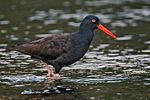 |
| American Oystercatcher American Oystercatcher The American Oystercatcher , occasionally called the American Pied Oystercatcher, is a member of family Haematopodidae. The bird is marked by its black and white body and a long, thick orange beak... |
H. palliatus | 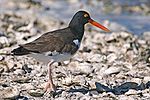 |
| Canarian Oystercatcher | H. meadewaldoi † Extinction In biology and ecology, extinction is the end of an organism or of a group of organisms , normally a species. The moment of extinction is generally considered to be the death of the last individual of the species, although the capacity to breed and recover may have been lost before this point... |
|
| African Oystercatcher | H. moquini | _standing_on_the_sand.jpg) |
| Eurasian Oystercatcher Eurasian Oystercatcher The Eurasian Oystercatcher Haematopus ostralegus, also known as the Common Pied Oystercatcher, or just Oystercatcher, is a wader in the oystercatcher bird family Haematopodidae. It is the most widespread of the oystercatchers, with three races breeding in western Europe, central Eurasia,... |
H. ostralegus |  |
| Pied Oystercatcher Pied Oystercatcher The Pied Oystercatcher, Haematopus longirostris, is a species of oystercatcher. It is a wading bird native to Australia and commonly found on its coastline. The similar South Island Pied Oystercatcher The Pied Oystercatcher, Haematopus longirostris, is a species of oystercatcher. It is a wading... |
H. longirostris |  |
| South Island Oystercatcher | H. finschi | 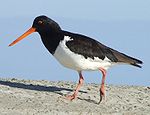 |
| Chatham Oystercatcher | H. chathamensis | |
| Variable Oystercatcher Variable Oystercatcher The Variable Oystercatcher is a species of wader in the Haematopodidae family.It is endemic to New Zealand. The Maori name is torea-pango. They are also known as 'red bills'.... |
H. unicolor | 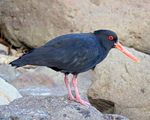 |
| Sooty Oystercatcher Sooty Oystercatcher The Sooty Oystercatcher, Haematopus fuliginosus, is a species of oystercatcher. It is a wading bird native to Australia and commonly found on its coastline. It prefers rocky coastlines, but will occasionally live in estuaries.... |
H. fuliginosus | 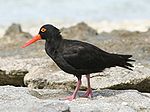 |
External links
- ARKive - images and movies of the oystercatcher (Haematopus ostralegus)
- Oystercatcher videos on the Internet Bird Collection
- Webcam Roof-breeding oystercatcher in BergenBergenBergen is the second largest city in Norway with a population of as of , . Bergen is the administrative centre of Hordaland county. Greater Bergen or Bergen Metropolitan Area as defined by Statistics Norway, has a population of as of , ....

